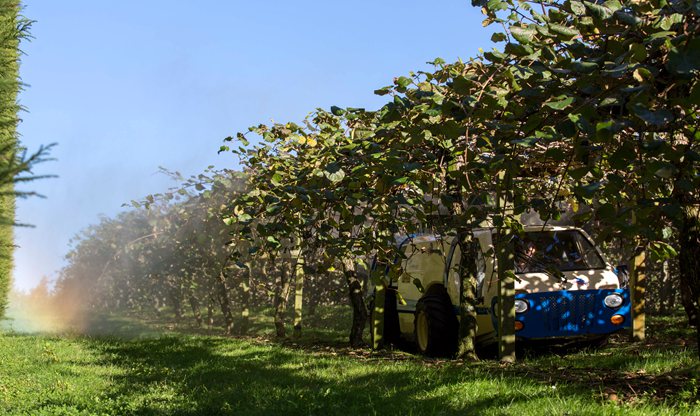Keywords: kiwifruit domestication, propagation, orchard management, scientific cooperation, genetics and breeding, germplasm collection, fair breeding

▲Golden Kiwi Orchard
Abstract:
In this review we give an account of the introduction of kiwifruit to Italy and the development of the industry, that in the 1990s became the world-leading player. Although kiwifruit were known in Italy since the 1930s as ornamental plants, the first kiwifruit orchards were established in Italy in the late 1960s, after several articles appeared in the French popular literature. Most kiwifruit plantings are still of the cultivar ‘Hayward’ but there are now orchards of several new cultivars, including the yellow-fleshed ones, while the baby kiwifruit (A. argute) plays a marginal role. The Italian kiwifruit industry makes up only a small part of Italian horticulture in general, but is nevertheless profitable and still expanding, after the small contraction in recent years owing to the spread of bacterial canker of kiwifruit. The orchard management has evolved as follows: the plant density has increased, owing mainly to the reduction of within row spacing from 6.0 to approx. 2.0 m; pergola and the T-bar has become in a few years the most popular training systems; the ratio of pollenizers: females has changed from 1:7-15 to 1:1-3, while artificial pollination is being generally adopted. Yields can vary from 30 to 60 t/ha according the cultivar, training and pruning and the use of plant growth regulators. The presence of leading kiwifruit scientists in New Zealand, the country that first domesticated the kiwifruit, led to an intense exchange of researchers between the two countries, promoted by the Plant & Food Institute of New Zealand and the Universities of Bologna and Udine, while the contact with Chinese scientists developed later, in some case encouraged by common research projects funded by the European Union (EU). Several Italian scientists have developed personal contacts with kiwifruit scientists of most kiwifruit growing countries. Studies on genetics of kiwifruit were initiated by the New Zealand breeders of DSIR and stimulated the development of breeding programs in New Zealand, followed on smaller scale in other countries, such as France, Italy, Japan, Korea and Chile. The development of linkage maps allowed the mapping of traits of interest and the development of the so-called marker-assisted selection (MAS). The release of EST database by the New Zealand scientists and the publication in 2013 of the kiwifruit genome sequence by Chinese scientists offered new tools for the MAS of agronomic traits and offered as well the opportunity to study biochemical pathways of the synthesis of flesh pigments, fruit aromas and other traits, now introduced into modern breeding programmes. In this review I give a brief account also of the success in promoting exchange of expertise and scientists within the kiwifruit community.

▲Golden Kiwi Orchard
关键词:猕猴桃驯化、繁殖、果园管理、科学合作、遗传育种、种质资源收集、公平育种
摘要:
在这篇综述中,我们介绍了猕猴桃传入意大利以及该行业的发展,该行业在20世纪90年代成为世界领先者。尽管猕猴桃自20世纪30年代以来在意大利就被称为观赏植物,但在法国通俗文学中出现几篇文章后,第一批猕猴桃果园于20世纪60年代末在意大利建立。大多数猕猴桃种植仍然是“海沃德”品种,但现在有几个新品种的果园,包括黄肉猕猴桃,而小猕猴桃(A.argute)的作用很小。意大利猕猴桃产业总体上只占意大利园艺业的一小部分,但在近年来由于猕猴桃细菌性溃疡的传播而出现小幅收缩后,该产业仍然盈利并仍在扩张。果园管理的演变如下:植物密度增加,主要是由于行距从6.0米减少到约2.0米;凉棚和T型杆已成为几年来最受欢迎的训练系统;授粉者与雌性的比例从1:7-15变为1:1-3,人工授粉被普遍采用。根据品种、训练和修剪以及植物生长调节剂的使用,产量可以从30吨/公顷到60吨/公顷不等。新西兰是第一个驯化猕猴桃的国家,新西兰有顶尖的猕猴桃科学家,这促使两国在新西兰植物与食品研究所以及博洛尼亚大学和乌迪内大学的推动下进行了密切的研究人员交流,而与中国科学家的联系后来发展起来,在某些情况下受到了欧盟资助的共同研究项目的鼓励。几位意大利科学家与大多数猕猴桃种植国的猕猴桃科学家建立了个人联系。猕猴桃遗传学研究由DSIR的新西兰育种者发起,促进了新西兰育种计划的发展,随后在法国、意大利、日本、韩国和智利等其他国家进行了较小规模的研究。连锁图谱的开发允许绘制感兴趣的性状图谱,并开发所谓的标记辅助选择(MAS)。新西兰科学家发布的EST数据库和中国科学家于2013年发表的猕猴桃基因组序列为农艺性状的MAS提供了新的工具,也为研究肉色素、水果香气和其他性状合成的生化途径提供了机会,这些途径现已引入现代育种计划。在这篇综述中,我还简要介绍了猕猴桃界在促进专业知识和科学家交流方面取得的成功。

▲▲golden kiwifruit vine

▲新西兰阳光金果



评论